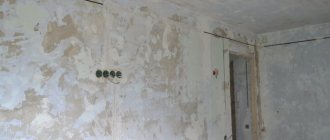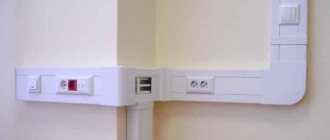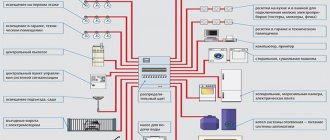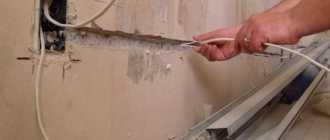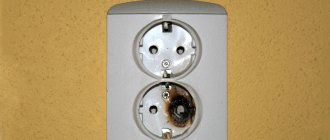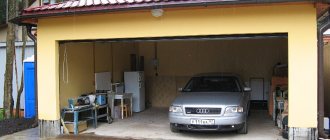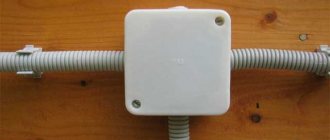What is a panel house?
Panel houses were built back in Soviet times.
They were a kind of economical option because they combined speed of construction and low cost of building materials. The panel structure was erected from reinforced concrete slabs, which were manufactured in special factories by pouring concrete into metal reinforcement. These slabs (or panels) were of two types - for floors or ceilings and for walls. The panel structure is akin to a house of cards; each wall in it is load-bearing. There can be no talk of any redevelopment here; just touch one wall and the whole house will come together. Nowadays such buildings are rarely erected, and people don’t particularly want to buy housing in panel houses. Still, brick buildings are considered more comfortable for living. They retain heat better, have increased noise insulation, and, of course, it is much easier to carry out repairs and remodeling in them. Especially when it comes to the issue of how to replace wiring.
The principle of electrical installation in a panel house
All cables are laid in panel channels that were made at the factory. These channels are specially made for easy installation of wires, and they are also placed only in certain places. In order to find longitudinal holes, you should be guided by switches and sockets. Where this fittings are located, there are channels. There is no other way to move them except to groove and knock out new holes.
Wires for chandeliers are laid through channels that are located in the ceiling. They are also installed in small spaces between the ceiling panel and the wall in those places where the ceiling molding will eventually stand. However, when replacing electrical wiring, it is necessary to take into account that even in houses of the same type or in the same house, but on different floors, the wiring can be done completely differently. This phenomenon is inherent due to the fact that several teams of electricians could work at one construction site and install cables in different ways.
Based on this, you cannot rely on the fact that the wiring requirements have been met, for example, that the switch is located under the distribution box, or that all wires are routed exactly vertically or horizontally. Such simple rules can be broken, so you should be careful and careful not to damage the old wires. In such situations, experience will help; it is important to always check before dismantling something and make sure that the cable will not be damaged.
The seams located between the panels on the ceiling or those between the wall and the ceiling are also used, as shown in the photo below:
The meter is usually installed on the staircase. After all, it is very difficult to recess it into the panel so that it does not stick out. However, it can be placed on external walls or in storage rooms. Usually, a cable is laid from the meter, which is located on the landing, into the apartment to the distribution board.
Option for electrical wiring in a two-room apartment of a panel house
As an example, you can look at the wiring diagram for a two-room apartment in a panel house of the standard twenty-first project. In such a panel house, also called frameless, almost all elements of the house, even internal partitions, were load-bearing, so it was impossible to cut separate channels for laying electrical wiring.
According to the diagram, all electrical wiring is divided into three main groups:
- Lighting and sockets in rooms 1 and 2. In each of the rooms, the contact box had its own pair of zero and phase from the distribution board, which made it possible to turn off the power supply and carry out repairs and maintenance of the wiring, using, for example, a chandelier lamp in the corridor;
- Lighting and power supply to the outlets in the corridor are organized according to the same principle, with their power supply being routed to a distribution box located at the front door. The wiring for the bell and emergency lighting was connected to the same box;
- The third group is lamps and sockets for the kitchen. In panel high-rise buildings that did not have a centralized gas supply, electric kitchen stoves were installed, so a cable with a cross-section of at least 4 mm2 was used for the kitchen;
- The last group is the bathroom and toilet. Electrical wiring to auxiliary rooms was connected to the input panel directly, without using a junction box.
And this is what the actual wiring looks like in a two-room apartment, sketched by the owner of the premises.
Instead of building four independent electrical wiring branches, the builders made two lines. One of them, marked in red, was used to supply room No. 2, a kitchen and a toilet with a bathroom. The blue branch of the electrical wiring fed room No. 1 and the corridor. Half of the ideas and ideas included in the wiring diagram for a panel house are simplified to the maximum.
And this is what a modern electrical wiring diagram looks like after repair and alteration with the replacement of one and a half millimeter aluminum noodles in the standard channels of the slabs of a panel house on VVG-3.
Why do you need to change the electrical wiring in your apartment?
Complete replacement of electrical wiring in an old apartment may be necessary in various situations. Over time, switches and sockets reach the end of their service life. In addition, powerful equipment may be used, so old wiring in a panel house or Khrushchev may not withstand such a load. It will begin to melt and sparkle. When planning a major renovation in a private house or apartment, you need to think carefully about carrying out electrical work.
The wiring needs to be changed if:
- old insulation exposed
- a technique is used that requires high power wiring (aluminum wires will not withstand the load)
- the wires are cracked or lost their properties
- the plugs in the shield box are often knocked out
- The lights in the rooms flicker and go out
- sockets sparkle
- it is impossible to connect several devices at once (for example, an air conditioner and a stove)
- heated floors and suspended ceilings are installed
Do-it-yourself electrical installation work allows you to switch from single-wire wiring in a panel house to three- and five-wire.
Chipping: nuances
We would like to emphasize that, according to regulatory documents, it is prohibited to ditch load-bearing walls and ceilings. However, they indicate that gating is prohibited only in the horizontal direction. Grooving in a vertical direction is possible.
Of course, you shouldn’t get too carried away here, since large vertical grooves also weaken the structure. The depth of the groove should not be more than 10 millimeters. The reinforcement cannot be destroyed.
The wiring can be secured in these grooves either using alabaster or using dowel clamps. In the second case, you will also need to drill small holes to install these dowels.
The grooves can be made either using a hammer drill or a wall chaser.
Helpful Hint: Gating is a complex and noisy process. To carry it out you need to wear safety glasses and a respirator. In this case, the process will go faster if you use a wall chaser, which is equipped with two laser circles and an installation capable of sucking out dust.
In addition to grooves for cables, you will also need to drill holes for socket boxes. The depth of recesses for socket boxes should not exceed 45 millimeters. The diameter can be 75-80 millimeters or more. This already depends on the size of the socket box.
Professional wall chaser
In the case when there is no desire to screed the floor, apply plaster or install a suspended ceiling, then replacing the wiring in a panel house becomes more difficult. As you know, it is best to hide wiring in the wall.
At the same time, in many places the cable must be placed horizontally. Of course, the wiring can be hidden in a groove, but horizontal grooves in panel houses are prohibited.
Here you can take advantage of the space that is between the wall and ceiling panels. Very often this space is filled with plaster, cotton wool and even various rags.
You can also try to use old “routes”. If their old wire is simply plastered over, then removing it and cleaning the channel is not difficult.
These difficulties will arise when this channel is filled with concrete. If none of the options can be used, then to replace the old wiring you will have to make an open one.
Materials and tools for replacing wiring
To carry out installation work to replace wiring, you need a standard set of electrician tools:
- electrical screwdrivers;
- pliers with insulated handles;
- knife for stripping insulation, side cutters;
- hammer drill with a set of drills and crowns for drilling holes, slotting attachments;
- wall chaser;
- voltage indicator;
- soldering iron, soldering accessories;
- roulette;
- bucket, spatulas.
A hidden wiring indicator can be a good help in your search. Even the most inexpensive detector will significantly reduce the amount of work required to knock down plaster when dismantling old wiring.
A hidden wiring indicator can be a good help. In addition, before starting work, you need to prepare all the necessary consumables in accordance with the project.
Here is a sample list of them:
- copper cables (two- or three-core, two types - for lighting and for sockets);
- socket boxes, electrical boxes;
- distribution boxes;
- switches and sockets;
- terminal blocks, insulating tape;
- corrugation or cable channels;
- alabaster;
- gypsum finishing putty.
Gasket in plaster
The essence of the method is the same as for grating; the wiring is laid in prepared grooves, but not in the walls, but in the plaster. This method is used when the coating thickness is at least 1 cm. The walls are not affected. Cable routing is carried out at the pre-finishing stage; the cable can be laid directly into a groove or into a cable channel.
The advantages of the method include:
- Maintaining the integrity of the walls.
- Possibility to perform hidden wiring.
- Less work compared to laying wires in the wall.
Disadvantages of the method:
- Wiring can only be replaced during repairs, as the decorative finish of the walls will be damaged.
Types of electrical wiring installation in panel houses
It is best to time the replacement of wiring to coincide with a major renovation of the apartment. During remodeling, replacing flooring or installing a suspended ceiling, additional opportunities arise for hiding wiring inside the resulting cavities. If you plan to decorate the walls with panels with insulation or plasterboard, the task is greatly simplified.
Laying wires under plaster
The most affordable way to arrange wiring is to lay electrical cables under the plastered surface of the walls or ceiling. For installation, you will need to create holes on the surface where fasteners will be installed. Then you can lay the wires and apply a layer of plaster on top.
The method allows you to direct several lines to each room. Not only lighting devices, but also air conditioning, heating devices, as well as other types of powerful household appliances can be supplied through their own line.
The disadvantage of this option is that plaster is practically not used in panel buildings. As a result, you will have to incur additional costs of money and time for plastering the surface.
Floor and ceiling installation
Replacing wiring is very appropriate when renovating floors in an apartment or installing a suspended (stretch) ceiling.
If a screed is poured onto the floor, the cables are stretched immediately before installing the beacons. Typically, double-insulated corrugated cables are used. This is done to provide reliable protection against mechanical damage and moisture during pouring of the concrete screed.
Wiring options for a panel house
Before changing electrical wiring, clearly decide which method is most suitable for you.
The most affordable option is to lay the wires along the surfaces of the walls and ceilings under the plaster. In this case, the cable is attached directly to the surfaces. You can pre-stretch it into a pipe: steel, electrical, plastic, corrugated plastic, or flexible metallized. Fastening to surfaces is carried out with special clips, clamps or brackets, for which you will need to drill small holes. After the conductors are secured, a layer of plaster is applied. Using this method, you can extend separate lines not only to lighting fixtures, but also to powerful household appliances (air conditioners, water heating boilers).
The disadvantage of this option is that additional monetary and physical costs will be required for plastering the surfaces.
Wiring in a panel house can also be placed on the floor if you later make a concrete screed on top. The conductors are pulled into corrugated pipes, laid on the floor and filled with concrete. The wires are also located in the suspended ceiling. The only drawback is that sockets cannot be mounted on floors and ceilings; you will still have to install them on the walls, and up to this point, trench the surface or lay wires under the plaster.
Replacing electrical wiring in a panel house can generally be done using an open installation method.
In this case, the conductors are mounted in pipes or special plastic cable ducts. It is advisable to choose places for installation where the possibility of mechanical damage to the cable box will be minimal. This, of course, is not the best option from an aesthetic point of view, but the installation of such wiring can be carried out when the renovation in the apartment has already been completely completed.
The gating method also remains relevant, only in concrete slabs it will require significant physical and time costs.
How to do wiring in a panel house
Where to lay the wires
The best way to install wiring in a panel house is in a screed, in a hollow (or plastered) ceiling, or on the walls under a layer of plaster. In this case, the ceilings and panels are not touched at all, only for fastening the cables. But it’s not always possible to do this correctly.
First of all, you need to find out from the owners how things will be with the floors and ceiling. If there is a screed in the floor - hooray. The main cable path will run through the corrugation in the floor, in the screed. If there is a suspended plasterboard-stretch ceiling, that’s also great. In these cases, power and signal cables run mainly along the floor and/or ceiling, and a little - vertically in grooves to sockets and switches.
The worst case scenario is that the ceiling and floors remain in place. A budget option when owners want to save on everything. That is, in other words, the electrician will have to suffer, ditching the walls. But the price for such work will be higher than usual. And if in a brick house, if you need to make a distribution box, it is done, then in a socket you need to think a hundred times. Most likely, there will be excess cable consumption compared to a brick house.
We must try to use the old wiring as much as possible. More precisely, the paths where it passes. This primarily applies to places where the old aluminum wire is simply plastered over - places at the joints of ceiling tiles, and in the seams between wall and ceiling tiles. You need to be guided by the fact that seams in panel houses are the best place for laying electrical wiring, for example as in the photo:
Laying power cables between ceiling tiles in a joint. You can use old channels in which old wiring runs to sockets and switches. That is if they are in old places. And if you manage to pull out the old wire, which is often covered with concrete.
As practice shows, it is better to immediately forget about the channels in wall panels. A good option is to use the space at the top where the wall and ceiling tiles meet. There are often cracks sealed with plaster or cotton wool (or some kind of rag):
The space between the wall and the ceiling is filled with cotton wool.
How to make grooves and recesses for boxes
An electrician's most faithful friend in this matter is a hammer drill.
For grooves, of course, it is much more convenient to use a wall chaser with two diamond wheels and dust extraction. But for now I’m only dreaming about this. An angle grinder will also work, but it can’t do it without a hammer drill.
Let's consider the most difficult case for an electrician when repairing a panel house - the floor is without screed, the ceiling is just being plastered. For the groove, a vertical line is drawn, and a groove is made along it. I use the spade attachment for my hammer drill. How to chip panel walls is an art, you need to get used to it, chip off centimeter by centimeter.
You must have a respirator mask and construction glasses. Otherwise, such work will be very harmful to health. The depth of the groove must be sufficient for laying the cable and fasteners (7-10 mm). On the other hand, the reinforcement begins deeper than 10 mm; it cannot be touched at all. On the third hand, you need to be in contact with the plasterers - perhaps the thickness of the plaster will be such that it won’t be necessary to dab at all.)
Groove in a panel wall.
After gating, we check that the boxes can be installed flush with the wall surface. The chipping is finished, let's check the depth. Under the installation box (standard diameter - 68 mm, depth - 45 mm) you need to make a recess with a diameter of 75...80 mm. An ordinary crown will not work for concrete; it will be enough for 2-3 sockets, and you will have to throw it away.
I don’t use crowns now, I do it this way. I make 8-10 holes around the volume of the box with a drill with a diameter of 8 or 10 mm. At this stage, the notch is already half formed. Then I use a pike to knock out the remaining concrete. About the cutting paths. We must try to act decently, although sometimes it can be very difficult. I mean that all wires should run parallel/perpendicular to the ceiling and walls.
And yet, it is not recommended to get carried away with horizontal grooves. The total length of horizontal grooves allowed is 2 meters per slab (wall panel). And it is generally prohibited to ditch ceilings; this can only be done in extreme cases, and for a length of no more than 15 cm.
Scoring of panel slabs
We have already mentioned that it is prohibited to touch load-bearing panel walls, this also applies to gating. But the ban applies to a greater extent to the installation of horizontal grooves. Making grooves for wires vertically is quite acceptable. However, there are still some restrictions; the grooves cannot be made too deep, which can lead to weakening of the structure (a depth of no more than 10 mm is allowed). The most important thing when installing the grooves is not to disturb the metal reinforcement.
Scoring of panel slabs
We have already mentioned that it is prohibited to touch load-bearing panel walls, this also applies to gating. But the ban applies to a greater extent to the installation of horizontal grooves. Making grooves for wires vertically is quite acceptable. However, there are still some restrictions; the grooves cannot be made too deep, which can lead to weakening of the structure (a depth of no more than 10 mm is allowed). The most important thing when installing the grooves is not to disturb the metal reinforcement.
No zigzags or inclined lines are allowed; grooves for sockets and switches are made in strictly even verticals.
The minimum distance between gas supply pipes and grooves should be 40 cm. The grooves for electrical wiring should be at least 15 cm away from window and door openings.
To cut grooves you will need a special tool, which costs a lot of money. It would be good if you have the opportunity to rent one from a professional electrician.
You need a grinder and a diamond blade is required for it, only it can cope with such a durable material as concrete. On the wall, you must first mark the route for laying the wire, and then make two parallel slits along these lines at a distance of 2 cm from each other. Now you will need a hammer drill; with its help, the remaining concrete between the cuts is removed.
Of course, the ideal option would be a wall chaser. This tool is essentially similar to a grinder, only it already has diamond discs built inside.
The distance between the discs can be adjusted in advance, as well as the depth of the furrow to be cut.
Another main advantage of the wall chaser is that it is equipped with a vacuum cleaner; installation dust does not extend beyond the casing. The only drawback is the price; in this case, even rental will be expensive.
Instructions for replacing wiring
There are several stages of work.
Blackout
Before replacing the wiring, you need to remove the old wires. To do this, you need to completely turn off the current in the room. After disconnecting, check the presence of current using a multimeter. We also remove furniture from the room (or move it away from the walls). We remove sockets and switches.
We prepare a temporary socket for connecting a hammer drill and any other power tools to it. We connect the socket immediately after the electric meter. We place this fittings on a board. We also equip the board with a 16-amp circuit breaker. After the outlet is prepared, we turn off the power to the room.
Dismantling
We remove the electrical wiring from the distribution boxes. The boxes are distinguished by the presence of round removable plastic lids. Disconnect the wires and carefully remove the old wires from the wall. If necessary, we use a metal detector to search for cables.
In panel buildings, dismantling work often consists of simply removing wires from the distribution box. However, there are exceptions when the wire is located in such a way that its pulling leads to the destruction of the building structure. In this case, you can isolate this area from the system. To do this, old wires are cut as much as possible and carefully insulated.
Channels for wires
After removing the electrical wiring, we prepare the walls for laying a new network. To do this, we make special channels in the wall. To get an even groove, we draw two lines on the wall in advance, spaced a couple of centimeters from each other. It’s good if there are old channels, since in this case gating will not be needed. We also mark the areas where sockets and switches will be installed.
We make the grooves with a hammer drill or grinder to a depth of about 4 centimeters. We use a hammer and chisel to remove small fragments of material.
Distribution boxes
The next stage is the installation of junction boxes. They must be immediately secured in the installation locations. The fixing agent is cement mortar. The cable is laid from the switchboard to the distribution boxes.
Laying wires
To determine whether the wires are laid correctly, use a level. The length of the cable must be in accordance with the length of the grooves. There should not be too many or too few wires. We connect the wires to each other with terminals. We make twists in such a way as not to mix up the ends of the wires in the phase. All twists are located in junction boxes.
The correct connection is made as follows:
- strip the end of the wire (3-5 centimeters);
- twist the cleaned ends together and shorten them by a centimeter;
- We insulate the wires using electrical tape or a terminal.
Next, you can route the cable from the distribution boxes to the consumers through pre-prepared recesses.
Inserting wires into the electrical panel
When running cables into the electrical panel, you should separate them into separate lines. It is recommended to draw up a distribution scheme in advance. Each line will need its own switch. This scheme is especially good if the house has powerful electrical appliances, since individual lines will better cope with transmitting the required current. Also, the presence of separate lines makes repair work with electrical wiring easier.
The wiring can be placed in corrugated or regular pipes laid in grooves. This will provide a higher level of safety compared to wiring placed under a layer of putty. It will also be easier to replace wiring in the future when removal simply involves pulling the cables out of the pipe through the junction box.
Installation of openings for sockets
If the drawn up diagram involves the installation of new sockets, another step of work will be required - drilling holes in the wall. To do this, you will need a pencil and a ruler, a hammer drill with an 8 mm drill, a crown attachment, and a spatula for removing concrete from the hole.
In the place where the socket will be placed, you need to draw a circle with a pencil with the diameter of the socket. In the center of the circle you need to make a hole 50-60 cm deep. Using a crown, outline the outline of the hole and drill about 14 holes with a drill according to the intended pattern. Now you can drill a hole to the full depth and knock out the remaining concrete into the shovel. Holes for distribution boxes are made in the same way.
System testing
We pour the solution into the grooves only after we are convinced that the electrical network is working. To do this, we need a multimeter with which we will ring the system. This device allows you to find a short circuit in case of an incorrectly installed connection.
If no defects are found in the system, we cover the grooves with putty and install sockets, switches and lighting fixtures. The temporary outlet is disconnected and new electrical wiring is connected in its place. There is nothing difficult about replacing the wiring in a panel house with your own hands. However, as mentioned earlier, it is recommended to coordinate the diagram with an electrician, and when performing installation work, you should strictly follow the instructions.
Ways to replace outdated wiring
In old panel houses, the laying of electrical wires was strictly regulated. For this reason, sockets, switches and power cables in these apartments are located in the same places.
Based on individual preferences and design features of the room, wiring replacement can be done in several ways:
- hide on the wall under a layer of plaster;
- place on the floor and fill with solution;
- cut grooves (grooves);
- place on the wall surface in cable channels;
- use technological voids in the suspended ceiling to place wires.
You need to know the possible location of the wires, because the easiest way is to dismantle the old wiring and install new wires in the vacant voids and grooves.
Under a layer of plaster
New wires are laid along the surface of the walls and in the ceiling . The old wiring is not dismantled; it is simply permanently disconnected from the power panel and “forgotten” in the wall.
The cables are fastened with special clamps and clips, for which holes are drilled. After this, a thick layer of plaster is applied to hide the cords.
Concrete screed
Energy distribution to consumers can be done on the floor followed by screeding the floor with concrete mortar. In this case, the power cables are hidden in corrugated pipes of small diameter and secured to the floor using clamps.
The disadvantage of this method is that sockets and switches will still have to be installed on a vertical surface, which means they will have to be hidden under plaster or tapped into the walls.
Cutting grooves in wall panels
If you lack technical skills, it is better to do without gating. If the procedure cannot be avoided, you need to prepare a grinder with a diamond blade for concrete or a gas cutter. Before you start cutting, you should mark the location of the future cable laying.
At a distance of 2 cm from each other, rotating disk to make shallow furrows . The depth of the cuts should not exceed 1 cm so as not to damage the steel reinforcement. Instead of a grinder, it is better to use a wall chaser equipped with a casing and a vacuum cleaner to collect dust.
Important! Independent cutting of grooves is allowed only in the vertical direction. It is forbidden to cut furrows and grooves horizontally, diagonally or at complex angles. This is due to the fact that in the absence of the necessary skills, the strength characteristics of the wall panel can be impaired.
Open laying method
The system is installed by attaching pipes and cable ducts to the walls . Rectangular and cylindrical boxes are fastened using tightening clamps.
Switching boxes are installed at the locations of the terminal connections. Installation locations should be chosen to minimize the risk of possible damage (for example, when opening a door).
Suspended ceiling
If you have a suspended or suspended ceiling, the best answer to the question of how to replace the wiring would be to route the wires inside the mounting box for suspended ceiling panels.
To change wiring located at the junctions of panels or between ceilings and walls, it is not necessary to use a wall chaser. It is enough to pick out the old plaster or putty using a hand tool or a hammer drill.
Step-by-step wiring replacement
Before changing the wiring you need to remove the old wires. The beginning of all work should be to cut off the supply of electricity to the workplace, that is, you need to turn off the input circuit breaker for the apartment and check that there is really no voltage.
Remove old switches and sockets, open junction boxes and disconnect wire connections. Sometimes in panel houses it is possible to pull out the entire wire from the old furrow through the junction box. But most often they simply begin to carefully pull out the conductor from the box; if in some place it is firmly stuck in the groove with alabaster mortar, then using a chisel and hammer they free it. Basically, if you won’t use some of the old grooves, then don’t fool yourself, leave the old wire there, just carefully insulate it on both sides.
Place the conductors in the grooves for new wiring and secure with plaster or alabaster mortar. Install distribution boxes and socket boxes in pre-drilled holes and insert wires into them. Make the necessary connections in the boxes, connect sockets and switches.
Where to start
You need to start work by drawing up a diagram of the future wiring. A diagram or drawing of the location of cables and consumption points is needed for at least three reasons:
- Fixing places for laying wires with dimensions. This information is especially important if you decide to do hidden wiring. If you later want to hang furniture or a TV, you will know exactly where the wires go so as not to accidentally damage them when drilling.
- Calculation of the number of necessary elements - socket boxes, sockets, switches, cables, cable ducts, connectors and other components.
- Determination of the optimal electrical communications scheme. The plan shows where it is best to lay the installation to take into account the location of the equipment, interior elements, and so on.
After drawing up the plan, components are calculated and purchased.
Step-by-step instructions for replacing old electrical wiring
We looked at the main methods of installing wiring in an apartment in a panel house. Now let's talk directly about the rules for replacing old electrical wiring. To make the material easier to understand, we will provide all stages of work in the form of step-by-step instructions. So, it is necessary to change the electrical wiring in the following sequence:
- Power outage in the apartment. First of all, you need to completely de-energize the line and make sure there is no voltage. The only thing that may be useful to you is one temporary socket for connecting a hammer drill, grinder or drill, without which it will be impossible to replace the wiring. The temporary socket is connected in the panel either to the input circuit breaker or to one of the group circuit breakers. All other lines, except for the temporary outlet, must be disconnected. You can verify that there is no voltage using a multimeter, which must also be prepared.
- Dismantling old fittings. At this stage, you should move all furniture and appliances away from the walls, gain access to all junction boxes, sockets and switches. First, remove the sockets and switches so that only the wires in the wall remain. After this, you will need to find the junction boxes and disconnect all the wire connections from them.
- The next thing to do is to remove the old wiring from the walls. If dismantling is very difficult or impossible without damaging the walls themselves, you can simply leave the old wires in the wall, having first disconnected them from the panel, cut them to the maximum possible length and insulated the ends with electrical tape. If possible, it is better to completely dismantle the wiring; leave it in the panels in the most extreme cases.
- Choosing a new method for laying electrical wiring (we wrote about this above). If a decision is made to lay the cable in new grooves, you must first draw up an electrical wiring diagram and make new grooves based on it. If you simply decide to replace the electrical wiring in a panel house without changing the circuit, it is enough to lay the cable in the old channels, having previously prepared them. You can also make open wiring in the baseboards, but this is not the most suitable and rational option.
- Installation of new wiring - installation of distribution boxes, laying separate lines to powerful consumers, installation of sockets and switches, assembly of the panel. We talked about all this in detail when we described the technology for installing electrical wiring in an apartment. We won’t repeat ourselves, just study the following material: https://samelectrik.ru/montazh-elektroprovodki-v-kvartire.html.
- Checking the installed electrical wiring. Using special instruments (megohmmeter and multimeter), you need to check the new wiring for short circuits, and also measure the cable insulation resistance. If everything is in order, you can proceed to sealing the grooves and finishing work. For testing work, it is better to call a specialist, pay a small amount, but be sure that the electrical installation performed is safe.
That's all the technology used to replace electrical wiring in a panel house.
Replacing electrical wiring on the ceiling
We know that wiring is not only placed on the walls, it also runs along the ceiling and supplies current to the lamp. Such wiring also needs to be changed, and here the question arises: how can this process be carried out in a panel house if a suspended ceiling is not used and plaster is not applied?
The solution is to use old channels or seams between the ceiling panels. Let us remind you once again: it is strictly prohibited to ditch the ceilings (ceiling or floor).
Using old channels to replace wiring can be called the most optimal. However, there is a nuance. The edges of the channel are often plastered with cement and will need to be broken up.
The cable should not be secured in the middle. The channel itself can be long and the process of pulling a new wire can be difficult.
Here we can attach the new cable to the old one and, by pulling out the old one, we will tighten the new one. In this case, do not bend the old aluminum wire too much. The fact is that waste aluminum is brittle and breaks quickly.
You can also stretch the wiring using steel wire. The wire is pushed through the entire channel and then a new wire is pulled in. The old wire will still have to be removed.
Actually, these are the methods for installing new wiring, and the choice of one of them depends on your desires and resources. As you can see, each method involves its own option for replacing and installing wiring, and depending on the chosen method, a new wiring diagram is drawn up.
Tools and materials
And so, before changing the wiring in an apartment located in a panel house, you need to take:
- Hammer with a crown and a set of drills for concrete. Using a crown, holes will be made for the socket boxes. Drills should be used for the holes into which the dowel clamps will be inserted.
- Knife.
- Hammer.
- Cold chisel.
- Pliers.
- Side cutters.
- Plus and minus screwdrivers.
- Indicator.
- Roulette.
- Soldering iron (power should not exceed 60 watts).
- Spatula (they will be used to secure mounting boxes and wires).
As for materials, their list consists of:
- three-core copper wire (for lighting, a wire with a cross-section of 1.5 square millimeters, for sockets - 2.5 square millimeters);
- mounting boxes (socket boxes);
- sockets;
- switches;
- dowels-clamps;
- alabaster;
- terminal blocks;
- insulating tapes;
- wire with a cross section of 1.5 millimeters.
Sequence of work
When you have prepared and approved the diagram, stocked up on all the tools and materials, you can begin replacing the wiring. From the very beginning, you need to prepare a special socket to which the hammer drill and other devices will be connected.
This outlet will be connected immediately after the meter. To create it, you need to install a double socket and a circuit breaker on the board (must be rated for 16 amperes). There should be a short cable running from the outlet.
When such an outlet is ready, turn off the electricity supply and connect this outlet. This connection involves disconnecting the cables coming from the meter from the apartment network and connecting it to our outlet.
As a result, the apartment will be de-energized, which is what is needed to safely replace the old wiring. Next, all sockets, switches and lamps are dismantled. After this, you need to find distribution boxes. This can be done either by tapping on the wall, or using a special device.
The next step is to open these boxes, disconnect the aluminum wires and pull them out.
In fact, the dismantling is complete. After this, new wiring is installed using one of the methods that we have already defined above. At the same time, large holes are made for the mounting boxes and the boxes are installed.
Next, the entire system is connected and checked for short circuits. At the end, putty is applied (if necessary), sockets, switches, chandeliers are installed and, after disconnecting the temporary working outlet, new apartment wiring is connected.
While disconnecting the special outlet and connecting the wiring that will replace the old one, the power must be turned off.
Let's summarize:
There are several main stages that will have to be completed when completely or partially replacing electrical wiring:
- de-energization - despite its apparent simplicity, is one of the most important stages. You need to look into the panel and turn off all the machines one by one. Then you should check whether the electric meter is spinning, measure the voltage in the sockets
- dismantling Remove worn wires with your own hands, after first removing chandeliers and lamps, boxes and sockets.
- draw up a plan for placing a new network for each room, including the bathroom, kitchen, toilet
- prepare the surface and perform installation, fixing wires along cable channels and installing boxes
- the last stage is checking the resulting network and finishing work. Only after making sure that the electrical network is working properly can you bury wires in the walls, carry out finishing work and glue wallpaper.
In addition, when carrying out electrical installation work in a residential building, you should take into account some rules regulated by fire safety standards and GOST:
- separation boxes, meters and sockets must be installed in an accessible place
- mounting height of sockets – 30 cm, switches – 90 cm.
- if there is a metal element nearby (radiator, pipe, etc.), the sockets are placed at a distance of 50 cm from it
- in the toilet it is only possible to install electrical sockets with water protection
- in the kitchen you must have at least three sockets, in the apartment at the rate of one socket per six sq.m.
In addition, it is necessary to draw up a diagram of how the cable will be laid along horizontal or vertical lines. This will not only make the job easier, but will also allow you to install the internal network correctly.
There are many ways to lay cables for an apartment electrical network. Installation can be carried out in old channels, which is the safest option, in a screed (with a wooden floor the situation is more complicated), in plaster or under the ceiling if you plan to make a suspended ceiling. It all depends on the preferences of the homeowners and the technical features of the premises.
In any case, it is necessary to comply with the safety of the work and fire safety and construction standards. This will allow you to install the required number of wires and perform the wiring as efficiently as possible.
Additional tips for electrical wiring
Calculation of the amount of cable must be done not only based on the area of the room. New wiring must be laid taking into account the configuration of the walls . The cable should be taken with a small margin (up to 10% of the required length). Part of the wire will be used for trimming and switching connections.
The number of sockets depends on the total number of household appliances that are planned to be used in the room, taking into account the need to charge mobile phones and other electronic devices. Switches should be located in convenient, easy to remember places. Hidden wiring is the most preferable from the point of view of modern interior design.
Approximate electrical wiring diagram in a three-room apartment in a panel house:
Legend: L1, L2, L3,...L7 – installation locations of ceiling chandeliers and lamps; P1, P2, P3,…P12 – sockets; B1, B2,…B7 are switches, A1 and A2 are input circuit breakers.
Thus, replacing worn-out wiring in apartments of a panel or brick house can be done independently if you have special tools and minimal skills in working with electricity. If both are missing, you must contact a management company or a private organization that provides electrical network repair services.
